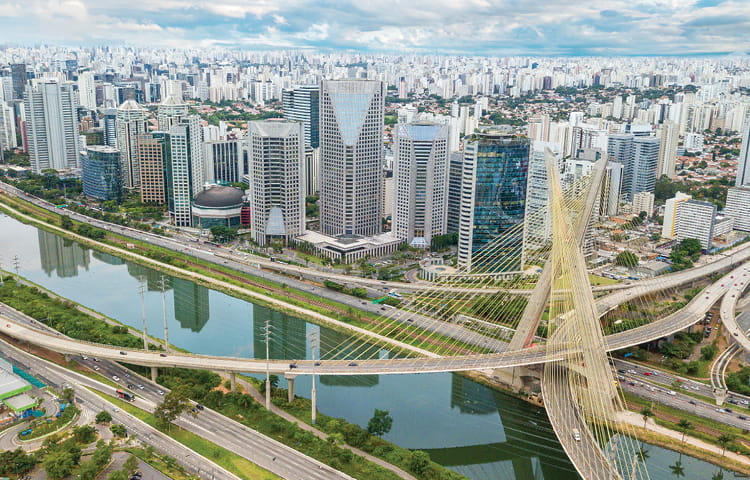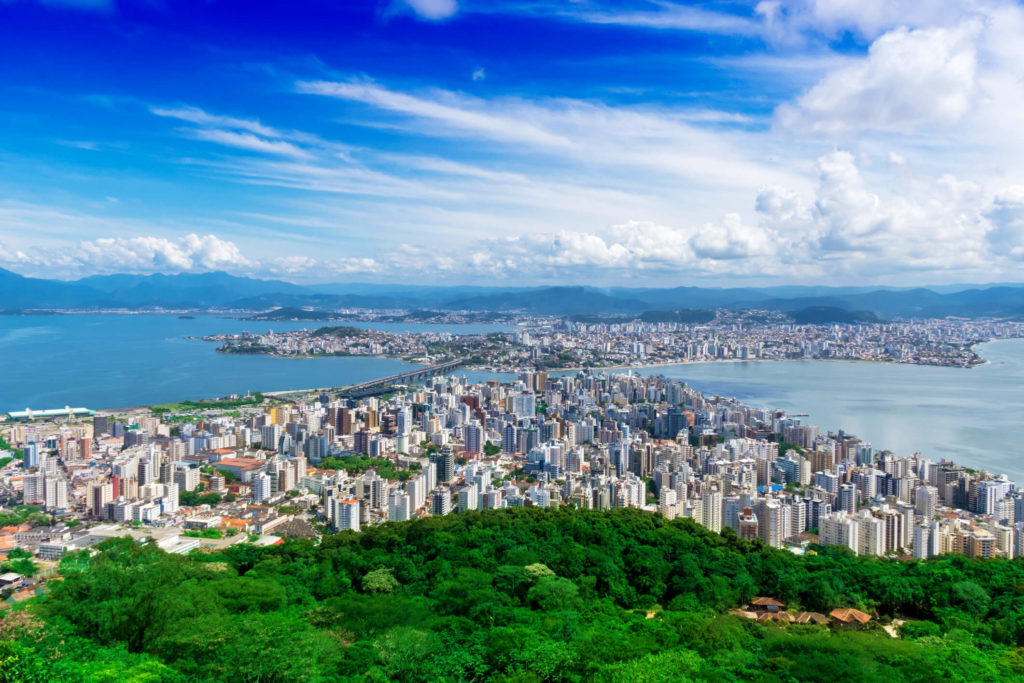RIO DE JANEIRO, BRAZIL – In addition to being the largest city in the country, São Paulo is also the most intelligent and connected in Brazil in 2020. This is shown in the Connected Smart Cities Ranking, released on Tuesday, September 8th, and exclusively published by EXAME newsmagazine.
Of the six editions of the ranking, the capital of São Paulo was also in first place in 2016 and 2017. Last year, however, Campinas took first place , whereas Curitiba came first in 2018.
The list with the most intelligent and connected cities is the result of a study prepared by Urban Systems consultancy, in partnership with Nacta. In total, 673 cities with over 50,000 inhabitants were surveyed. The goal is to identify the cities with greatest development potential in the country.

The assessment took into account 70 indicators that include mobility, environment, urbanism, technology, entrepreneurship, and economy. Of the total requirements, 69 were rated 1. Only the mayor’s schooling indicator was rated 0.5. As a result, the maximum score reached 69.5.
Connected Smart Cities 2020 Ranking
The 100 most intelligent and connected cities in Brazil
| Position | City (State) | Grade |
|---|---|---|
| 1st | São Paulo (São Paulo) | 37,901 |
| 2nd | Florianópolis (Santa Catarina) | 37,224 |
| 3rd | Curitiba (Paraná) | 36,545 |
| 4th | Campinas (São Paulo) | 36,303 |
| 5th | Vitória (Espírito Santo) | 36,251 |
| 6th | São Caetano do Sul (São Paulo) | 36,107 |
| 7th | Santos (São Paulo) | 35,423 |
| 8th | Brasília (Federal District) | 35,361 |
| 9th | Porto Alegre (Rio Grande do Sul) | 34,869 |
| 10th | Belo Horizonte (Minas Gerais) | 34,608 |
| 11th | Niterói (Rio de Janeiro) | 34,411 |
| 12th | Rio de Janeiro (Rio de Janeiro) | 34,297 |
| 13th | Barueri (São Paulo) | 34,214 |
| 14th | Campo Grande (Mato Grosso do Sul) | 34,002 |
| 15th | Recife (Pernambuco) | 33,557 |
| 16th | Balneário Camboriú (Santa Catarina) | 33,449 |
| 17th | Jaguariuna (São Paulo) | 33,421 |
| 18th | Itajaí (Santa Catarina) | 33,078 |
| 19th | Blumenau (Santa Catarina) | 33,017 |
| 20th | São José dos Campos (São Paulo) | 32,979 |
| 21st | Vinhedo (São Paulo) | 32,763 |
| 22nd | Jundiaí (São Paulo) | 32,588 |
| 23rd | Joinville (Santa Catarina) | 32,557 |
| 24th | Maringá (Paraná) | 32,397 |
| 25th | Londrina (Paraná) | 32,296 |
| 26th | Praia Grande (São Paulo) | 32,277 |
| 27th | Salvador (Bahia) | 32,276 |
| 28th | São Bernardo do Campo (São Paulo) | 32,209 |
| 29th | Fortaleza (Ceará) | 31,863 |
| 30th | Sorocaba (São Paulo) | 31,849 |
| 31st | Ribeirão Preto (São Paulo) | 31,841 |
| 32nd | Palmas (Tocantins) | 31,779 |
| 33rd | Santo André (São Paulo) | 31,432 |
| 34th | Viçosa (Minas Gerais) | 31,384 |
| 35th | Juiz de Fora (Minas Gerais) | 31,232 |
| 36th | Goiânia (Goiás) | 31,231 |
| 37th | Paulínia (São Paulo) | 31,208 |
| 38th | Teresina (Piauí) | 31,196 |
| 39th | Santana de Parnaíba (São Paulo) | 31,176 |
| 40th | Limeira (São Paulo) | 31,161 |
| 41st | São José do Rio Preto (São Paulo) | 31,138 |
| 42nd | Santa Maria (Rio Grande do Sul) | 30,994 |
| 43rd | Indaiatuba (São Paulo) | 30,982 |
| 44th | Piracicaba (São Paulo) | 30,934 |
| 45th | Nova Lima (Minas Gerais) | 30,852 |
| 46th | Linhares (Espírito Santo) | 30,847 |
| 47th | Americana (São Paulo) | 30,812 |
| 48th | Presidente Prudente (São Paulo) | 30,764 |
| 49th | Pato Branco (Paraná) | 30,747 |
| 50th | Resende (Rio de Janeiro) | 30,722 |
| 51st | Cascavel (Paraná) | 30,688 |
| 52nd | Chapecó (Santa Catarina) | 30,617 |
| 53rd | Uberaba (Minas Gerais) | 30,610 |
| 54th | Itu (São Paulo) | 30,591 |
| 55th | Betim (Minas Gerais) | 30,578 |
| 56th | Petrópolis (Rio de Janeiro) | 30,505 |
| 57th | Macaé (Rio de Janeiro) | 30,402 |
| 58th | Itatiba (São Paulo) | 30,396 |
| 59th | Araras (São Paulo) | 30,284 |
| 60th | Eusébio (Ceará) | 30,254 |
| 61st | Ipatinga (Minas Gerais) | 30,214 |
| 62nd | Jaraguá do Sul (Santa Catarina) | 30,182 |
| 63rd | Valinhos (São Paulo) | 30,169 |
| 64th | Itumbiara (Goiás) | 30,128 |
| 65th | Osasco (São Paulo) | 30,097 |
| 66th | Amparo (São Paulo) | 30,092 |
| 67th | Cachoeiro de Itapemirim (Espírito Santo) | 30,058 |
| 68th | Manaus (Amazonas) | 30,057 |
| 69th | Ouro Preto (Minas Gerais) | 30,049 |
| 70th | São Carlos (São Paulo) | 29,911 |
| 71st | Itupeva (São Paulo) | 29,890 |
| 72nd | Uberlândia (Minas Gerais) | 29,873 |
| 73rd | Caraguatatuba (São Paulo) | 29,845 |
| 74th | Lençóis Paulista (São Paulo) | 29,828 |
| 75th | Natal (Rio Grande do Norte) | 29,702 |
| 76th | Cajamar (São Paulo) | 29,678 |
| 77th | Congonhas (Minas Gerais) | 29,604 |
| 78th | João Pessoa (Paraíba) | 29,581 |
| 79th | Foz do Iguaçu (Paraná) | 29,580 |
| 80th | Botucatu (São Paulo) | 29,572 |
| 81st | Jaboticabal (São Paulo) | 29,528 |
| 82nd | Sobral (Ceará) | 29,522 |
| 83rd | Itapema (Santa Catarina) | 29,321 |
| 84th | Três Lagoas (Mato Grosso do Sul) | 29,295 |
| 85th | Jacareí (São Paulo) | 29,233 |
| 86th | Poá (São Paulo) | 29,232 |
| 87th | São José dos Pinhais (Paraná) | 29,220 |
| 88th | Cotia (São Paulo) | 29,188 |
| 89th | Mariana (Minas Gerais) | 29,181 |
| 90th | Itabira (Minas Gerais) | 29,100 |
| 91st | Hortolândia (São Paulo) | 20,096 |
| 92nd | Andradina (São Paulo) | 29,085 |
| 93rd | Vitória da Conquista (Bahia) | 29,071 |
| 94th | Caxias do Sul (Rio Grande do Sul) | 29,056 |
| 95th | Cuiabá (Mato Grosso) | 29,033 |
| 96th | Toledo (Paraná) | 29,000 |
| 97th | Colatina (Espírito Santo) | 29,978 |
| 98th | Registro (Sâo Paulo) | 28,942 |
| 99th | Araraquara (São Paulo) | 28,920 |
| 100th | Boituva (São Paulo) | 28,906 |
Source: Urban Systems Consulting
The city of São Paulo stood out in four main indicators: urbanism (2nd place); entrepreneurship (2nd); economy (5th); and governance (12th).
“When we think of an intelligent city, it is not necessarily technological. It is an axis of mobility and accessibility, shortening distance, and building connections. São Paulo is the city with the greatest independence and economic diversity in the country. Since the approval of the Master Plan, in 2014, the environment has been favorable for this”, explains Willian Rigon, Urban Systems executive in charge of the Connected Smart Cities Ranking.
Compared to 2019, all the general scores fell slightly. According to Rigon, the Covid-19 pandemic had a moderate impact on the survey because most of it was conducted before the first case of the disease in the country.

Florianópolis climbed five positions
The capital of Santa Catarina rose from 7th place in 2019 to 2nd place in 2020, with one of the highest ascents in the ranking. According to Rigon, education was the driving force behind the city’s upswing. “This issue influences all others because it creates a growth ecosystem,” he says.
Event debates smart cities revolution
More than a list, the Connected Smart Cities Ranking is a resource that public managers can use to identify the strengths and weaknesses of cities. Furthermore, it allows them to become aware of and identify experiences that work in different places in Brazil.
“We want the study to improve people’s quality of life. It is a tool for public managers to use in order to improve their city. Each one needs to understand the specificities of the regions and be inspired by good practices”, emphasizes Paula Faria, creator of the Connected Smart Cities and Mobility platform and CEO of Necta.
To discuss how to accomplish this transformation in Brazilian cities, the Connected Smart Cities and Mobility Digital Experience is being held from Tuesday, September 8th to Thursday, 10th. For the first time, the event is held fully online and will feature around 70 panels and 300 national and international speakers.
The entire program and enrolment can be found on its website.
Source: Exame

